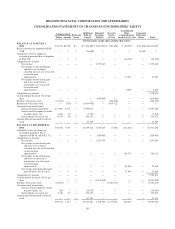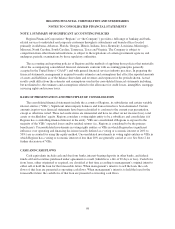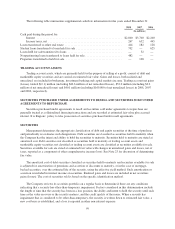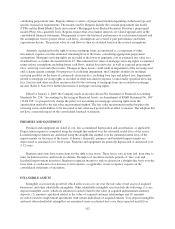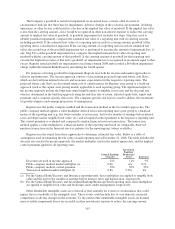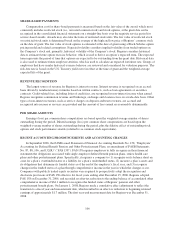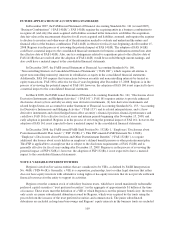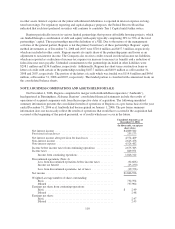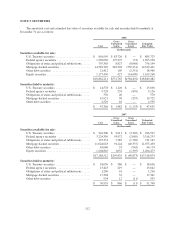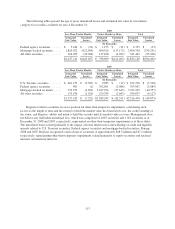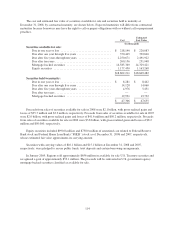Regions Bank 2008 Annual Report Download - page 114
Download and view the complete annual report
Please find page 114 of the 2008 Regions Bank annual report below. You can navigate through the pages in the report by either clicking on the pages listed below, or by using the keyword search tool below to find specific information within the annual report.Refer to Note 10 for further discussion of the results of the goodwill and other identifiable intangibles
impairment tests.
FORECLOSED PROPERTY AND OTHER REAL ESTATE
Other real estate acquired in satisfaction of indebtedness (“foreclosure”) is carried in other assets at the
lower of the recorded investment in the loan or fair value less estimated cost to sell the property. At the date of
transfer, when the recorded investment in the loan exceeds the property’s fair value less cost to sell, write-downs
are recorded as charge-offs in the allowance. Subsequent to transfer, additional write-downs are recorded as other
non-interest expense. Gain or loss on the sale of foreclosed property and other real estate is included in other
non-interest expense. See Note 11 for details.
From time to time, assets classified as premises and equipment are transferred to held for sale for various
reasons. These assets are carried in other assets at the lower of the recorded investment in the asset or fair value
less estimated cost to sell based upon the property’s appraised value at the date of transfer. Any write-downs of
property held for sale are recorded as other non-interest expense. At December 31, 2008 and 2007, the carrying
values of premises and equipment held for sale were approximately $31.6 million and $81.8 million,
respectively.
DERIVATIVE FINANCIAL INSTRUMENTS AND HEDGING ACTIVITIES
The Company enters into derivative financial instruments to manage interest rate risk, facilitate asset/
liability management strategies and manage other exposures. These instruments primarily include interest rate
swaps, options on interest rate swaps, interest rate caps and floors, and forward sale commitments. All derivative
financial instruments are recognized on the consolidated balance sheets as other assets or other liabilities at fair
value as required by FAS 133. Regions enters into master netting agreements with counterparties and/or requires
collateral based on counterparty credit ratings to cover exposures.
Derivative financial instruments that qualify under FAS 133 in a hedging relationship are designated, based
on the exposure being hedged, as either fair value or cash flow hedges. For derivative financial instruments not
designated as fair value or cash flow hedges, gains and losses related to the change in fair value are recognized in
earnings during the period of change in fair value as brokerage, investment banking and capital markets income.
Fair value hedge relationships mitigate exposure to the change in fair value of an asset, liability or firm
commitment. Under the fair value hedging model, gains or losses attributable to the change in fair value of the
derivative instrument, as well as the gains and losses attributable to the change in fair value of the hedged item,
are recognized in earnings in the period in which the change in fair value occurs. Hedge ineffectiveness is
recognized to the extent the changes in fair value of the derivative do not offset the changes in fair value of the
hedged item as other non-interest expense. The corresponding adjustment to the hedged asset or liability is
included in the basis of the hedged item, while the corresponding change in the fair value of the derivative
instrument is recorded as an adjustment to other assets or other liabilities, as applicable.
Cash flow hedge relationships mitigate exposure to the variability of future cash flows or other forecasted
transactions. For cash flow hedge relationships, the effective portion of the gain or loss related to the derivative
instrument is recognized as a component of other comprehensive income. The ineffective portion of the gain or
loss related to the derivative instrument, if any, is recognized in earnings as other non-interest expense during the
period of change. Amounts recorded in other comprehensive income are recognized in earnings in the period or
periods during which the hedged item impacts earnings.
The Company formally documents all hedging relationships between hedging instruments and the hedged
items, as well as its risk management objective and strategy for entering into various hedge transactions. The
Company performs periodic assessments to determine whether the hedging relationship has been highly effective
in offsetting changes in fair values or cash flows of hedged items and whether the relationship is expected to
continue to be highly effective in the future.
104



